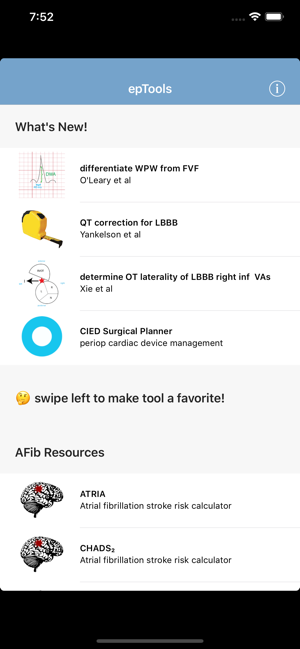價格:免費
更新日期:2020-08-21
檔案大小:88.2 MB
目前版本:3.8.1
版本需求:系統需求:iOS 9.0 或以後版本。相容裝置:iPhone、iPad、iPod touch。
支援語言:英語

epTools is a platform for the evaluation of heart rhythm disorders. It is a universal app running on iPhone and iPad devices.
Resources include algorithms commonly used to localize arrhythmia substrates and reference guides to assist in the identification of clinical conditions involving abnormalities of cardiac rhythm. Algorithms are implemented via an intuitive user interface. These algorithms guide the user through a series of questions to arrive at an answer while providing a graphical visualization of their progress and result of their analysis.
Use of the save path to image feature allows users to save an image of the current decision path when using many of the decision analysis tools included. These images, which appear in the photo album, may be useful to communicate findings with colleagues.
Users may access scientific reference material cited in the app. Many of the references are available for free or are easily accessible by subscription holders.
Via 12-lead ecgs localize accessory pathways using algorithms of Arruda, Milstein, Taguchi , D'Avila, Li and Pambrun et al and differentiate WPW from FVF using O'Leary et al.

Localization of atrial tachycardias: Algorithms provided (based on Ellenbogen et al and Kistler et al) assist in the localization of ATs from 12-lead electrocardiogram. The De Ponti et al tool calculates the appropriate mapping window to identify the isthmus of an AT. The Miyazaki et al tool localizes macro reentrant ATs based on pacing responses.
Tools to assist with diagnosis of preexcitation variants, J-wave syndromes and entrainment site localization are included.
Localization of ischemic ventricular tachycardia: Three algorithms are provided (based on Miller et al, Segal et al and Andreu et al) to assist in the localization of exit sites for ventricular tachycardia in the setting of single and multiple myocardial infarction based on findings on 12-lead electrocardiograms during ventricular tachycardia.
Localization of idiopathic ventricular tachycardia and premature ventricular contractions: A reference is provided consisting of ECG findings for various idiopathic ventricular arrhythmia locations as well as a tool to search this reference by property. The Ito and Park et al algorithms assist in the localization of ventricular ectopic activity and tachycardia. 7 tools are provided to differentiate right from left ventricular (aortic cusp) outflow tract arrhythmias via calculation of the QRS-RVA Interval the V₂S/V₃R Index, TZ Index, V₂ Transition ratio and the R/S-wave Amplitude and R-Wave Duration, R-wave amplitude indices.
2 tools are provided to differentiate endocardial from epicardial VTs (calculation of the MDI, Daniels et al and the Berruezo criteria).

Disease Assessment: Consensus criteria for ARVD/C and Short QT Syndrome. 5-yr risk of SCD in HCM (O'Mahon et al), inadequate DFT safety margin (Hsu et al ), LA arrhythmogenic substrate (Kosiuk et al), 30-day mortality after PPM and ICD lead extraction (Brunner et al), 1-4 year mortality rate for 1° prevention ICD placement (Bilchick et al, SHOCKED), Shanghai score (Brugada Syndrome), VT prediction in ARVD/C (Cadrin-Tourigny et al.), Suspicious Index In Lyme Carditis (SILC), PADIT infection and ABC-VT Risk Score calculators are provided.
A CIED/electrocautery manager is included. Detailed preoperative plans can be created and shared by text or email.
A clinical guidelines and consensus statement resource is provided.
Tools to differentiate SVT from VT using 12-lead electrocardiogram features utilizing the Brugada and Verckei et al algorithms.

Tools for CHADS₂, CHA₂DS₂VASc and ATRIA stroke risk, HAS-BLED bleeding risk scores, QT correction heart rate (Bazett or Fredericia, Hodges) and left bundle branch block (Bogosian and Yankelson et al) and a CL to bpm interconverter are provided.
Reference examples using the included tools are available on our website (www.busy-being-born.com/examples).

支援平台:iPhone, iPad
